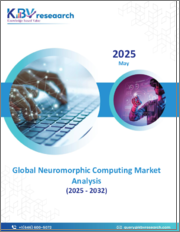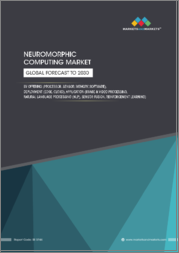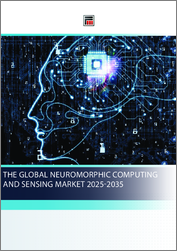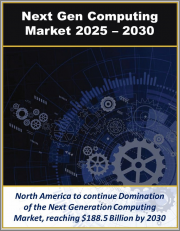
|
시장보고서
상품코드
1547062
뉴로모픽 컴퓨팅 시장 : 세계 산업 분석, 규모, 점유율, 성장, 동향 및 예측(2024-2031년)Neuromorphic Computing Market: Global Industry Analysis, Size, Share, Growth, Trends, and Forecast, 2024-2031 |
||||||
Persistence Market Research는 최근 뉴로모픽 컴퓨팅(Neuromorphic Computing) 세계 시장에 대한 종합적인 보고서를 발표했습니다. 이 보고서는 촉진요인, 동향, 기회 및 과제를 포함한 주요 시장 역학을 철저히 평가하고 시장 구조에 대한 심층적인 통찰력을 제공합니다.
주요 인사이트
- 뉴로모픽 컴퓨팅 시장 규모(2024년) : 54억 달러
- 2031년 예상 시장 규모(2031년) : 204억 4달러
- 세계 시장 성장률(2024-2031년 CAGR) : 20.9%
뉴로모픽 컴퓨팅 시장 - 조사 범위
뉴로모픽 컴퓨팅은 인간 뇌의 신경 구조와 기능을 모방하여 머신러닝 및 인공지능 용도의 계산 효율과 성능을 향상시키는 기술입니다. 이 기술은 특수 하드웨어와 소프트웨어를 활용하여 데이터를 보다 효율적으로 처리하여 로봇 공학, 자율 주행 자동차, 인지 컴퓨팅 등의 분야에서 발전을 가능하게 합니다. 뉴로모픽 컴퓨팅 시장은 전자, 자동차, 의료, 국방 등의 산업을 대상으로 엣지 컴퓨팅, 패턴 인식, 실시간 데이터 처리를 지원하는 솔루션을 제공합니다.
시장 성장의 촉진요인:
세계 뉴로모픽 컴퓨팅 시장은 효율적이고 확장 가능한 처리 능력을 필요로 하는 고급 AI 및 머신러닝 시스템에 대한 수요 증가 등 몇 가지 주요 요인에 의해 주도되고 있습니다. 자율주행차, 스마트시티, 사물인터넷(IoT) 기기 등 용도 증가로 인해 복잡한 실시간 데이터 처리 작업을 처리하는 뉴로모픽 솔루션에 대한 수요가 크게 증가하고 있습니다. 또한, 뇌에서 영감을 받은 칩과 뉴로모픽 프로세서 개발 등 뉴로모픽 하드웨어의 기술 발전은 성능과 에너지 효율을 향상시켜 시장 성장을 더욱 촉진할 것으로 보입니다.
시장 성장 억제요인 :
뉴로모픽 컴퓨팅 시장은 유망한 성장 전망에도 불구하고 높은 개발 비용, 제한된 전문 인력 가용성, 기존 시스템과의 통합 문제 등의 문제에 직면해 있습니다. 뉴로모픽 하드웨어와 소프트웨어의 복잡한 특성은 연구개발에 많은 투자가 필요하기 때문에 중소기업과 신규 진출기업에게는 장벽이 될 수 있습니다. 또한, 시장의 급속한 발전은 지속적인 기술 업데이트와 진보를 필요로 하며, 이는 조직이 이에 대응하기 어려워 전체 시장 채택에 영향을 미칠 수 있습니다.
시장 기회 :
뉴로모픽 컴퓨팅 시장은 인공지능의 발전, 엣지 컴퓨팅의 확대, 에너지 효율적인 컴퓨팅 솔루션에 대한 관심 증가로 인해 큰 성장 기회를 맞이하고 있습니다. 헬스케어 진단, 산업 자동화, 강화된 사이버 보안 솔루션과 같은 새로운 용도에 뉴로모픽 기술이 통합되면서 시장 확대의 새로운 길이 열리고 있습니다. 이러한 기회를 활용하고 빠르게 변화하는 시장 환경에서 경쟁력을 유지하기 위해서는 전략적 파트너십, R&D 투자, 비용 효율적인 뉴로모픽 솔루션의 개발이 매우 중요합니다.
본 보고서에서 다룬 주요 질문들
- 뉴로모픽 컴퓨팅 시장의 세계 성장을 가속하는 주요 요인은?
- 뉴로모픽 컴퓨팅 솔루션을 가장 적극적으로 채택하고 있는 용도과 산업은?
- 뉴로모픽 컴퓨팅 시장 경쟁 구도를 형성하는 기술 발전은 어떤 것이 있는가?
- 뉴로모픽 컴퓨팅 시장에 기여하고 있는 주요 기업은 어디이며, 경쟁력을 유지하기 위해 어떤 전략을 채택하고 있는가?
- 세계 뉴로모픽 컴퓨팅 시장의 새로운 트렌드와 전망은?
목차
제1장 주요 요약
제2장 시장 개요
- 시장 범위와 정의
- 시장 역학
- 성장 촉진요인
- 성장 억제요인
- 기회
- 과제
- 주요 동향
- 거시경제 요인
- 세계의 부문별 전망
- 세계의 GDP 성장 전망
- 세계의 헬스케어 지출 전망
- COVID-19의 영향 분석
- 예측 요인 - 관련성과 영향
제3장 부가가치 통찰
- 제품 채택 분석
- 기술 평가
- 규제 상황
- 밸류체인 분석
- 최종 용도/마켓플레이스 리스트
- 최종사용자(업계) 리스트
- 주요 거래와 합병
- PESTLE 분석
- Porter의 Five Forces 분석
제4장 세계의 뉴로모픽 컴퓨팅 시장 전망 : 분석(2019-2023년)과 예측(2024-2031년)
- 주요 하이라이트
- 시장 규모(10억 달러)와 전년대비 성장률
- 절대액 기회
- 시장 규모(10억 달러) 분석과 예측
- 과거 시장 규모(10억 달러) 분석, 2019-2023년
- 현재 시장 규모(10억 달러) 분석과 예측, 2024년-2031년
- 세계의 뉴로모픽 컴퓨팅 시장 전망 : 용도 유형
- 서론/주요 조사 결과
- 과거 시장 규모(10억 달러) 분석, 용도 유형별, 2019-2023년
- 현재 시장 규모(10억 달러) 분석과 예측, 용도 유형별, 2024-2031년
- 시장의 매력 분석 : 용도 유형
- 세계의 뉴로모픽 컴퓨팅 시장 전망 : 전개
- 서론/주요 조사 결과
- 과거 시장 규모(10억 달러) 분석, 전개 형태별, 2019-2023년
- 현재 시장 규모(10억 달러) 분석과 예측, 전개 형태별, 2024-2031년
- 시장의 매력 분석 : 전개
- 세계의 뉴로모픽 컴퓨팅 시장 전망 : 최종 용도
- 서론/주요 조사 결과
- 과거 시장 규모(10억 달러) 분석, 최종 용도별, 2019-2023년
- 현재 시장 규모(10억 달러) 분석과 예측, 최종 용도별, 2024-2031년
- 시장의 매력 분석 : 최종 용도
- 세계의 뉴로모픽 컴퓨팅 시장 전망 : 컴포넌트
- 서론/주요 조사 결과
- 과거 시장 규모(10억 달러) 분석, 컴포넌트별, 2019-2023년
- 현재 시장 규모(10억 달러) 분석과 예측, 컴포넌트별, 2024-2031년
- 시장의 매력 분석 : 컴포넌트
제5장 세계의 뉴로모픽 컴퓨팅 시장 전망 : 지역
- 주요 하이라이트
- 과거 시장 규모(10억 달러) 분석, 지역별, 2019-2023년
- 현재 시장 규모(10억 달러) 분석과 예측, 지역별, 2024-2031년
- 북미
- 유럽
- 동아시아
- 남아시아 및 오세아니아
- 라틴아메리카
- 중동 및 아프리카
- 시장의 매력 분석 : 지역
제6장 북미의 뉴로모픽 컴퓨팅 시장 전망 : 분석(2019-2023년)과 예측(2024-2031년)
제7장 유럽의 뉴로모픽 컴퓨팅 시장 전망 : 분석(2019-2023년)과 예측(2024-2031년)
제8장 동아시아의 뉴로모픽 컴퓨팅 시장 전망 : 분석(2019-2023년)과 예측(2024-2031년)
제9장 남아시아 및 오세아니아의 뉴로모픽 컴퓨팅 시장 전망 : 분석(2019-2023년)과 예측(2024-2031년)
제10장 북미의 뉴로모픽 컴퓨팅 시장 전망 : 분석(2019-2023년)과 예측(2024-2031년)
제11장 중동 및 아프리카의 뉴로모픽 컴퓨팅 시장 전망 : 분석(2019-2023년)과 예측(2024-2031년)
제12장 경쟁 구도
- 시장 점유율 분석, 2024년
- 시장 구조
- 경쟁 강도 매핑 : 시장별
- 경쟁 대시보드
- 기업 개요(상세 - 개요, 재무, 전략, 최근 동향)
- BrainChip Holdings Ltd.
- Intel Corporation
- Qualcomm
- SynSense AG
- Samsung Electronics Co. Ltd
- IBM Corporation
- SK Hynix Inc.
- General Vision Inc.
- GrAI Matter Labs
- Innatera Nanosystems
제13장 부록
- 조사 방법
- 조사의 전제조건
- 두자어 및 약어
Persistence Market Research has recently released a comprehensive report on the worldwide market for neuromorphic computing. The report offers a thorough assessment of crucial market dynamics, including drivers, trends, opportunities, and challenges, providing detailed insights into the market structure.
Key Insights:
- Neuromorphic Computing Market Size (2024E):US$5.4 Bn
- Projected Market Value (2031F):US$20.4 Bn
- Global Market Growth Rate (CAGR 2024 to 2031):20.9%
Neuromorphic Computing Market - Report Scope:
Neuromorphic computing mimics the neural structure and functioning of the human brain to enhance computational efficiency and performance in machine learning and artificial intelligence applications. This technology leverages specialized hardware and software to process data more effectively, enabling advancements in fields such as robotics, autonomous vehicles, and cognitive computing. The neuromorphic computing market caters to industries including electronics, automotive, healthcare, and defense, offering solutions that support edge computing, pattern recognition, and real-time data processing.
Market Growth Drivers:
The global neuromorphic computing market is propelled by several key factors, including the increasing demand for advanced AI and machine learning systems that require efficient and scalable processing capabilities. The rise in applications involving autonomous vehicles, smart cities, and IoT devices creates a significant need for neuromorphic solutions to handle complex and real-time data processing tasks. Additionally, technological advancements in neuromorphic hardware, such as the development of brain-inspired chips and neuromorphic processors, offer improved performance and energy efficiency, further driving market growth.
Market Restraints:
Despite promising growth prospects, the neuromorphic computing market faces challenges related to high development costs, limited availability of specialized talent, and integration issues with existing systems. The complex nature of neuromorphic hardware and software requires substantial investment in research and development, which can pose barriers for smaller players and new entrants. Furthermore, the market's rapid evolution necessitates continuous updates and advancements in technology, which can be challenging for organizations to keep pace with, impacting overall market adoption.
Market Opportunities:
The neuromorphic computing market presents significant growth opportunities driven by advancements in artificial intelligence, the expansion of edge computing, and the increasing focus on energy-efficient computing solutions. The integration of neuromorphic technology in emerging applications such as healthcare diagnostics, industrial automation, and enhanced cybersecurity solutions opens new avenues for market expansion. Strategic partnerships, investment in R&D, and the development of cost-effective neuromorphic solutions are crucial for leveraging these opportunities and maintaining a competitive edge in the rapidly evolving market landscape.
Key Questions Answered in the Report:
- What are the primary factors driving the growth of the neuromorphic computing market globally?
- Which applications and industries are most actively adopting neuromorphic computing solutions?
- How are technological advancements shaping the competitive landscape of the neuromorphic computing market?
- Who are the key players contributing to the neuromorphic computing market, and what strategies are they employing to stay competitive?
- What are the emerging trends and future prospects in the global neuromorphic computing market?
Competitive Intelligence and Business Strategy:
Leading players in the global neuromorphic computing market, including IBM Corporation, Intel Corporation, and Qualcomm Technologies, Inc., focus on innovation, product differentiation, and strategic partnerships to gain a competitive edge. These companies invest in developing advanced neuromorphic chips, cognitive computing platforms, and edge AI solutions to meet diverse market needs. Collaborations with academic institutions, research organizations, and technology developers facilitate access to cutting-edge technologies and foster market growth. Emphasis on strategic investments, technological advancements, and addressing industry-specific challenges is essential for maintaining market leadership and driving the future of neuromorphic computing.
Key Companies Profiled:
- IBM Corporation
- Intel Corporation
- Qualcomm Technologies, Inc.
- BrainChip Holdings Ltd.
- Synopsis Inc.
- AiOnChip Technologies
- Knowm Inc.
- Gyrfalcon Technology Inc.
- Numenta Inc.
- Cortica Inc.
Neuromorphic Computing Market Segmentation
By Application Type
- Signal Processing
- Image Processing
- Data Processing
- Object Detection
By Deployment
- Edge
- Cloud
By End Use
- Consumer Electronics
- Automotive
- Healthcare
- Military & Defense
By Component
- Hardware
- Software
- Services
By Region
- North America
- Europe
- Asia Pacific
- South America
- The Middle East and Africa
Table of Contents
1. Executive Summary
- 1.1. Global Neuromorphic Computing Market Snapshot, 2024-2031
- 1.2. Market Opportunity Assessment, 2024-2031, US$ Bn
- 1.3. Key Market Trends
- 1.4. Future Market Projections
- 1.5. Premium Market Insights
- 1.6. Industry Developments and Key Market Events
- 1.7. PMR Analysis and Recommendations
2. Market Overview
- 2.1. Market Scope and Definition
- 2.2. Market Dynamics
- 2.2.1. Drivers
- 2.2.2. Restraints
- 2.2.3. Opportunity
- 2.2.4. Challenges
- 2.2.5. Key Trends
- 2.3. Macro-Economic Factors
- 2.3.1. Global Sectorial Outlook
- 2.3.2. Global GDP Growth Outlook
- 2.3.3. Global Healthcare Spending Outlook
- 2.4. COVID-19 Impact Analysis
- 2.5. Forecast Factors - Relevance and Impact
3. Value Added Insights
- 3.1. Product Adoption Analysis
- 3.2. Technology Assessment
- 3.3. Regulatory Landscape
- 3.4. Value Chain Analysis
- 3.4.1. List of End-use/Marketplaces
- 3.4.1.1. Retail
- 3.4.1.2. Audiology
- 3.4.1.3. E-Commerce
- 3.4.2. List of End User (Industry)
- 3.4.1. List of End-use/Marketplaces
- 3.5. Key Deals and Mergers
- 3.6. PESTLE Analysis
- 3.7. Porter's Five Force Analysis
4. Global Neuromorphic Computing Market Outlook: Historical (2019-2023) and Forecast (2024-2031)
- 4.1. Key Highlights
- 4.1.1. Market Size (US$ Bn) and Y-o-Y Growth
- 4.1.2. Absolute $ Opportunity
- 4.2. Market Size (US$ Bn) Analysis and Forecast
- 4.2.1. Historical Market Size (US$ Bn) Analysis, 2019-2023
- 4.2.2. Current Market Size (US$ Bn) Analysis and Forecast, 2024-2031
- 4.3. Global Neuromorphic Computing Market Outlook: Application Type
- 4.3.1. Introduction / Key Findings
- 4.3.2. Historical Market Size (US$ Bn) Analysis, By Application Type, 2019-2023
- 4.3.3. Current Market Size (US$ Bn) Analysis and Forecast, By Application Type, 2024-2031
- 4.3.3.1. Signal Processing
- 4.3.3.2. Image Processing
- 4.3.3.3. Data Processing
- 4.3.3.4. Object Detection
- 4.3.3.5. Others
- 4.4. Market Attractiveness Analysis: Application Type
- 4.5. Global Neuromorphic Computing Market Outlook: Deployment
- 4.5.1. Introduction / Key Findings
- 4.5.2. Historical Market Size (US$ Bn) Analysis, By Deployment, 2019-2023
- 4.5.3. Current Market Size (US$ Bn) Analysis and Forecast, By Deployment, 2024-2031
- 4.5.3.1. Edge
- 4.5.3.2. Cloud
- 4.6. Market Attractiveness Analysis: Deployment
- 4.7. Global Neuromorphic Computing Market Outlook: End-use
- 4.7.1. Introduction / Key Findings
- 4.7.2. Historical Market Size (US$ Bn) Analysis, By End-use, 2019-2023
- 4.7.3. Current Market Size (US$ Bn) Analysis and Forecast, By End-use, 2024-2031
- 4.7.3.1. Consumer Electronics
- 4.7.3.2. Automotive
- 4.7.3.3. Healthcare
- 4.7.3.4. Military & Defense
- 4.7.3.5. Others
- 4.8. Market Attractiveness Analysis: End-use
- 4.9. Global Neuromorphic Computing Market Outlook: Component
- 4.9.1. Introduction / Key Findings
- 4.9.2. Historical Market Size (US$ Bn) Analysis, By Component, 2019-2023
- 4.9.3. Current Market Size (US$ Bn) Analysis and Forecast, By Component, 2024-2031
- 4.9.3.1. Hardware
- 4.9.3.2. Software
- 4.9.3.3. Services
- 4.10. Market Attractiveness Analysis: Component
5. Global Neuromorphic Computing Market Outlook: Region
- 5.1. Key Highlights
- 5.2. Historical Market Size (US$ Bn) Analysis, By Region, 2019-2023
- 5.3. Current Market Size (US$ Bn) Analysis and Forecast, By Region, 2024-2031
- 5.3.1. North America
- 5.3.2. Europe
- 5.3.3. East Asia
- 5.3.4. South Asia and Oceania
- 5.3.5. Latin America
- 5.3.6. Middle East & Africa
- 5.4. Market Attractiveness Analysis: Region
6. North America Neuromorphic Computing Market Outlook: Historical (2019-2023) and Forecast (2024-2031)
- 6.1. Key Highlights
- 6.2. Pricing Analysis
- 6.3. Historical Market Size (US$ Bn) Analysis, By Market, 2019-2023
- 6.3.1. By Country
- 6.3.2. By Application Type
- 6.3.3. By Deployment
- 6.3.4. By End-use
- 6.3.5. By Component
- 6.4. Current Market Size (US$ Bn) Analysis and Forecast, By Country, 2024-2031
- 6.4.1. U.S.
- 6.4.2. Canada
- 6.5. Current Market Size (US$ Bn) Analysis and Forecast, By Application Type, 2024-2031
- 6.5.1. Signal Processing
- 6.5.2. Image Processing
- 6.5.3. Data Processing
- 6.5.4. Object Detection
- 6.5.5. Others
- 6.6. Current Market Size (US$ Bn) Analysis and Forecast, By Deployment, 2024-2031
- 6.6.1. Edge
- 6.6.2. Cloud
- 6.7. Current Market Size (US$ Bn) Analysis and Forecast, By End-use, 2024-2031
- 6.7.1. Consumer Electronics
- 6.7.2. Automotive
- 6.7.3. Healthcare
- 6.7.4. Military & Defense
- 6.7.5. Others
- 6.8. Current Market Size (US$ Bn) Analysis and Forecast, By Component, 2024-2031
- 6.8.1. Hardware
- 6.8.2. Software
- 6.8.3. Services
- 6.9. Market Attractiveness Analysis
7. Europe Neuromorphic Computing Market Outlook: Historical (2019-2023) and Forecast (2024-2031)
- 7.1. Key Highlights
- 7.2. Pricing Analysis
- 7.3. Historical Market Size (US$ Bn) Analysis, By Market, 2019-2023
- 7.3.1. By Country
- 7.3.2. By Application Type
- 7.3.3. By Deployment
- 7.3.4. By End-use
- 7.3.5. By Component
- 7.4. Current Market Size (US$ Bn) Analysis and Forecast, By Country, 2024-2031
- 7.4.1. Germany
- 7.4.2. France
- 7.4.3. U.K.
- 7.4.4. Italy
- 7.4.5. Spain
- 7.4.6. Russia
- 7.4.7. Turkey
- 7.4.8. Rest of Europe
- 7.5. Current Market Size (US$ Bn) Analysis and Forecast, By Application Type, 2024-2031
- 7.5.1. Signal Processing
- 7.5.2. Image Processing
- 7.5.3. Data Processing
- 7.5.4. Object Detection
- 7.5.5. Others
- 7.6. Current Market Size (US$ Bn) Analysis and Forecast, By Deployment, 2024-2031
- 7.6.1. Edge
- 7.6.2. Cloud
- 7.7. Current Market Size (US$ Bn) Analysis and Forecast, By End-use, 2024-2031
- 7.7.1. Consumer Electronics
- 7.7.2. Automotive
- 7.7.3. Healthcare
- 7.7.4. Military & Defense
- 7.7.5. Others
- 7.8. Current Market Size (US$ Bn) Analysis and Forecast, By Component, 2024-2031
- 7.8.1. Hardware
- 7.8.2. Software
- 7.8.3. Services
- 7.9. Market Attractiveness Analysis
8. East Asia Neuromorphic Computing Market Outlook: Historical (2019-2023) and Forecast (2024-2031)
- 8.1. Key Highlights
- 8.2. Pricing Analysis
- 8.3. Historical Market Size (US$ Bn) Analysis, By Market, 2019-2023
- 8.3.1. By Country
- 8.3.2. By Application Type
- 8.3.3. By Deployment
- 8.3.4. By End-use
- 8.3.5. By Component
- 8.4. Current Market Size (US$ Bn) Analysis and Forecast, By Country, 2024-2031
- 8.4.1. China
- 8.4.2. Japan
- 8.4.3. South Korea
- 8.5. Current Market Size (US$ Bn) Analysis and Forecast, By Application Type, 2024-2031
- 8.5.1. Signal Processing
- 8.5.2. Image Processing
- 8.5.3. Data Processing
- 8.5.4. Object Detection
- 8.5.5. Others
- 8.6. Current Market Size (US$ Bn) Analysis and Forecast, By Deployment, 2024-2031
- 8.6.1. Edge
- 8.6.2. Cloud
- 8.7. Current Market Size (US$ Bn) Analysis and Forecast, By End-use, 2024-2031
- 8.7.1. Consumer Electronics
- 8.7.2. Automotive
- 8.7.3. Healthcare
- 8.7.4. Military & Defense
- 8.7.5. Others
- 8.8. Current Market Size (US$ Bn) Analysis and Forecast, By Component, 2024-2031
- 8.8.1. Hardware
- 8.8.2. Software
- 8.8.3. Services
- 8.9. Market Attractiveness Analysis
9. South Asia and Oceania Neuromorphic Computing Market Outlook: Historical (2019-2023) and Forecast (2024-2031)
- 9.1. Key Highlights
- 9.2. Pricing Analysis
- 9.3. Historical Market Size (US$ Bn) Analysis, By Market, 2019-2023
- 9.3.1. By Country
- 9.3.2. By Application Type
- 9.3.3. By Deployment
- 9.3.4. By End-use
- 9.3.5. By Component
- 9.4. Current Market Size (US$ Bn) Analysis and Forecast, By Country, 2024-2031
- 9.4.1. India
- 9.4.2. Southeast Asia
- 9.4.3. ANZ
- 9.4.4. Rest of South Asia & Oceania
- 9.5. Current Market Size (US$ Bn) Analysis and Forecast, By Application Type, 2024-2031
- 9.5.1. Signal Processing
- 9.5.2. Image Processing
- 9.5.3. Data Processing
- 9.5.4. Object Detection
- 9.5.5. Others
- 9.6. Current Market Size (US$ Bn) Analysis and Forecast, By Deployment, 2024-2031
- 9.6.1. Edge
- 9.6.2. Cloud
- 9.7. Current Market Size (US$ Bn) Analysis and Forecast, By End-use, 2024-2031
- 9.7.1. Consumer Electronics
- 9.7.2. Automotive
- 9.7.3. Healthcare
- 9.7.4. Military & Defense
- 9.7.5. Others
- 9.8. Current Market Size (US$ Bn) Analysis and Forecast, By Component, 2024-2031
- 9.8.1. Hardware
- 9.8.2. Software
- 9.8.3. Services
- 9.9. Market Attractiveness Analysis
10. North America Neuromorphic Computing Market Outlook: Historical (2019-2023) and Forecast (2024-2031)
- 10.1. Key Highlights
- 10.2. Pricing Analysis
- 10.3. Historical Market Size (US$ Bn) Analysis, By Market, 2019-2023
- 10.3.1. By Country
- 10.3.2. By Application Type
- 10.3.3. By Deployment
- 10.3.4. By End-use
- 10.3.5. By Component
- 10.4. Current Market Size (US$ Bn) Analysis and Forecast, By Country, 2024-2031
- 10.4.1. Brazil
- 10.4.2. Mexico
- 10.4.3. Rest of Latin America
- 10.5. Current Market Size (US$ Bn) Analysis and Forecast, By Application Type, 2024-2031
- 10.5.1. Signal Processing
- 10.5.2. Image Processing
- 10.5.3. Data Processing
- 10.5.4. Object Detection
- 10.5.5. Others
- 10.6. Current Market Size (US$ Bn) Analysis and Forecast, By Deployment, 2024-2031
- 10.6.1. Edge
- 10.6.2. Cloud
- 10.7. Current Market Size (US$ Bn) Analysis and Forecast, By End-use, 2024-2031
- 10.7.1. Consumer Electronics
- 10.7.2. Automotive
- 10.7.3. Healthcare
- 10.7.4. Military & Defense
- 10.7.5. Others
- 10.8. Current Market Size (US$ Bn) Analysis and Forecast, By Component, 2024-2031
- 10.8.1. Hardware
- 10.8.2. Software
- 10.8.3. Services
- 10.9. Market Attractiveness Analysis
11. Middle East & Africa Neuromorphic Computing Market Outlook: Historical (2019-2023) and Forecast (2024-2031)
- 11.1. Key Highlights
- 11.2. Pricing Analysis
- 11.3. Historical Market Size (US$ Bn) Analysis, By Market, 2019-2023
- 11.3.1. By Country
- 11.3.2. By Application Type
- 11.3.3. By Deployment
- 11.3.4. By End-use
- 11.3.5. By Component
- 11.4. Current Market Size (US$ Bn) Analysis and Forecast, By Country, 2024-2031
- 11.4.1. GCC Countries
- 11.4.2. Egypt
- 11.4.3. South Africa
- 11.4.4. Northern Africa
- 11.4.5. Rest of Middle East & Africa
- 11.5. Current Market Size (US$ Bn) Analysis and Forecast, By Application Type, 2024-2031
- 11.5.1. Signal Processing
- 11.5.2. Image Processing
- 11.5.3. Data Processing
- 11.5.4. Object Detection
- 11.5.5. Others
- 11.6. Current Market Size (US$ Bn) Analysis and Forecast, By Deployment, 2024-2031
- 11.6.1. Edge
- 11.6.2. Cloud
- 11.7. Current Market Size (US$ Bn) Analysis and Forecast, By End-use, 2024-2031
- 11.7.1. Consumer Electronics
- 11.7.2. Automotive
- 11.7.3. Healthcare
- 11.7.4. Military & Defense
- 11.7.5. Others
- 11.8. Current Market Size (US$ Bn) Analysis and Forecast, By Component, 2024-2031
- 11.8.1. Hardware
- 11.8.2. Software
- 11.8.3. Services
- 11.9. Market Attractiveness Analysis
12. Competition Landscape
- 12.1. Market Share Analysis, 2024
- 12.2. Market Structure
- 12.2.1. Competition Intensity Mapping By Market
- 12.2.2. Competition Dashboard
- 12.3. Company Profiles (Details - Overview, Financials, Strategy, Recent Developments)
- 12.3.1. BrainChip Holdings Ltd.
- 12.3.1.1. Overview
- 12.3.1.2. Segments and Products
- 12.3.1.3. Key Financials
- 12.3.1.4. Market Developments
- 12.3.1.5. Market Strategy
- 12.3.2. Intel Corporation
- 12.3.3. Qualcomm
- 12.3.4. SynSense AG
- 12.3.5. Samsung Electronics Co. Ltd
- 12.3.6. IBM Corporation
- 12.3.7. SK Hynix Inc.
- 12.3.8. General Vision Inc.
- 12.3.9. GrAI Matter Labs
- 12.3.10. Innatera Nanosystems
- 12.3.1. BrainChip Holdings Ltd.
13. Appendix
- 13.1. Research Methodology
- 13.2. Research Assumptions
- 13.3. Acronyms and Abbreviations



















